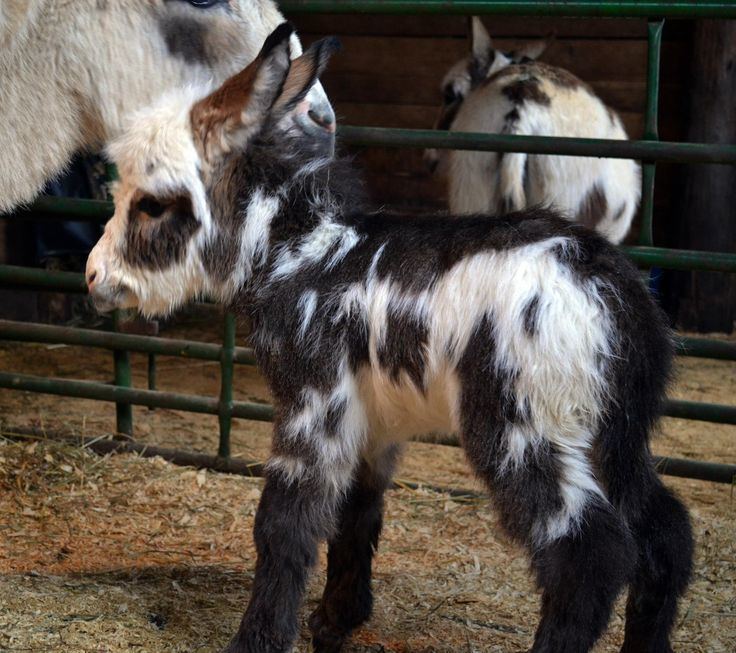 | ||
Similar American Miniature Horse, American mammoth donkey, Poitou donkey, Mule, Hinny | ||
Donkeys in North America constitute approximately 0.1% of the worldwide donkey population. They were first brought to the New World by Christopher Columbus in the 15th century, and once arriving in Mexico in the 16th century, spread northward into what today is the United States. Some donkeys were bred in the eastern part of the continent from imported European stock. In the gold rush era of 19th century, additional numbers came to the western United States for use as pack animals and working animals in the mining industry. Some sources suggest that there are no true North American donkey breeds as such, and it is true that donkeys in Canada and the United States are classified according to their size as miniature, standard or mammoth donkeys. However, there are US-based purebred registries for the spotted ass (a color breed), the American mammoth jackstock, and the miniature donkey,. The three size classifications have been reported as breeds to the Domestic Animal Diversity database of the UN Food and Agriculture Organization by the National Animal Germplasm Program of the Agricultural Research Service of the US Department of Agriculture, along with the burro (a small standard donkey that includes a feral population), and the spotted ass.
Contents
- Adorable baby donkey
- Early history
- Miniature donkey
- Standard donkey
- American mammoth donkey
- Spotted ass
- Breed associations
- References
Adorable baby donkey
Early history
The first asses came to the Americas on ships of the second voyage of Christopher Columbus, and were landed at Hispaniola in 1495. In the early days of the Conquest, jackasses were highly valued as sires for mules, which were esteemed as riding animals by the Spanish, and reserved for the nobility. Mules were bred for expeditions to mainland America, with males preferred for pack animals and the females for riding. The first shipment of mules, along with three jacks and twelve jennies, arrived in Mexico from Cuba ten years after the conquest of the Aztecs in 1521. Mules were used in silver mines, and each Spanish outpost in the empire bred its own mules from its own jack. Donkeys arrived in large numbers in the western United States during the nineteenth century gold rushes, as pack animals and for use in mines and ore-grinding mills. The major use of donkeys came to an end with the end of the mining boom and the introduction of railroads in the West. With little value, many animals were turned loose to become the populations of free-roaming burros that inhabit the West today.
Miniature donkey
Miniature donkeys are 9 hands (36 inches, 91 cm) or less at the withers when fully grown, and are usually measured in inches.Almost every miniature donkey has a black or brown cross on its back, extending from the neck to the lower back. In the 20th century, donkeys came to be more frequently kept as pets in the United States and in other wealthy nations. In 1929 Robert Green of New York imported seven donkeys of the small indigenous Sardinian breed to the United States. The first foal was born in the same year. Although never considered miniature in their country of origin, these animals were soon known as Miniature or Miniature Mediterranean donkeys. Green was a lifelong advocate, and said of them: "Miniature donkeys possess the affectionate nature of a Newfoundland, the resignation of a cow, the durability of a mule, the courage of a tiger, and an intellectual capability only slightly inferior to man's." By 1935 there were 52 of them, and some were sold. Further Sardinian donkeys were imported, as well as similar but quite distinct Sicilian animals. A breed registry was opened in 1958 by Bea Langfeld, who was the first professional breeder of miniature donkeys in the United States; it was turned over to the American Donkey and Mule Society in 1987.
Standard donkey
Small standard donkeys stand 9 to 12 hands (36 to 48 inches, 91 to 122 cm) at the withers, large standard donkeys stand from over 12 to 13.2 hands (48 to 54 inches, 122 to 137 cm) for jennies, and over 12 to 14 hands (48 to 56 inches, 122 to 142 cm) for jacks and geldings. They are commonly measured in inches alone, rather than in hands.
American mammoth donkey
The American mammoth donkey also called American mammoth jackstock, or simply mammoth jack, is the largest North American donkey. Jennies are taller than 13.2 hands (54 inches, 137 cm) at the withers, and American mammoth jacks and geldings over 14 hands (56 inches, 142 cm). They are variously measured both in inches only or in hands. This type descended from several large European donkeys imported to the United States from the mid- to late 18th century. Breeds that may have influenced the mammoth include the Maltese, Poitou, Andalusian, Majorcan and Catalan donkeys.
Spotted ass
A spotted ass is any kind of donkey, mule or hinny that has a spotted coat. To be registered with the American Council of Spotted Asses, the animal must have at least two spots behind the throatlatch and above the legs.
